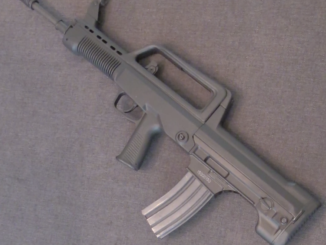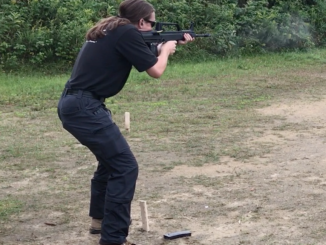During World War One, Joseph Alphonse Huot, a Canadian machinist and blacksmith living in Quebec, designed a conversion of the Ross MkIII rifle to become an automatic rifle. The Ross was the standard issue Canadian rifle at the beginning of the war, and Huopt wanted to find a way to economically provide Canadian forces with an automatic weapon. His conversion functioned by mounting a gas piston onto the side of the Ross barrel, adding a large action cover and 25-round drum magazine, and a Lewis-style cooling shroud over the barrel.
In initial testing with Canadian forces, the Huot performed well. It was seriously considered for adoption, but had to undergo British testing and approval before that could happen. In British testing (by now near the end of the war), it was found to run well enough and have some positive attributes, but not sufficient to justify replacement of the Lewis Gun. It was rejected, and Canadian forces finished the war with the Lewis instead. Huot had spent several years privately developing the weapon and two more working on salary for the Canadian military, and had gone into considerable personal debt for the project. He had secured a deal to receive royalties on production, but that of course came to naught when the design was rejected. Ultimately, he was compensated $25,000 in 1936 (of the $36,000 he claimed to have spent).
Only five of the guns were made in total, with four known to still exist. Two of them are in Ottawa at the Canadian War Museum and one in the Seaforth Highlanders Museum in Vancouver and one in the Army Museum in Halifax.
Thanks to the Canadian War Museum for providing me access to film this Huot for you! For more on the Huot, see my previous article.




The most obvious comparison is to the various Swiss Schmidt-Rubin experimental semi-automatic conversions. Like them, the Huot being based on a straight-pull bolt action means it doesn’t require an external “cam path” device to turn the bolt, unlike the British “Sword Guard” or Australian Charleton conversions of the SMLE.
Also like them, the shield to prevent the bolt from hitting the shooter in the face pretty much eliminates any chance of a proper cheek-weld.
cheers
eon
“(…) the shield to prevent the bolt from hitting the shooter in the face pretty much eliminates any chance of a proper cheek-weld.(…)”
Yasnikov converting Mannlicher to full-auto used Permamnent metal stop was installed into the stock behind the grip see photos: http://hungariae.com/Mann95Ru.htm
The Snabb was a generic conversion method of turn bolt rifles into straight pulls for converting into semi autos. The rear portion didn’t look too bad, the gas trap system could use some refinement, IMHO. https://www.forgottenweapons.com/snabb-semiauto-conversion-of-a-dutch-mannlicher/
Correction – The Charleton was a New Zealand Conversion of the Long Lee Enfield, also manufactured in Australia, Cheers, Phil
What are the two black things on the wall behind Ian?
@JimWestText – It looks like Ian is in front of a set of rolling storage cabinets. These will be large heavy cabinets running on rails. They are pushed together to save space. The black things look like crank handles to shift them aside to get access to the contents.
Another inventive Canadian, even before Jean Garand. Impressive!
“(…)inventive Canadian(…)”
See also Gerald Bull who developed method of experimental research of supersonic flight without aerodynamic tunnel.
https://en.wikipedia.org/wiki/Gerald_Bull
I knew people who worked for him. He was totally unscrupulous businessman; habitually ignored politically based restrictions. That was also reason why he ended up as he did.
In 1914 or even 1915 this gun might have been acceptable as a temporary stop-gap measure. By 1918 however there was no reason to put it into production when the much better Lewis Gun was already available.
The time taken to refine the design meant that it was probably one of the best, if not the best, conversion of a bolt action rifle to a light machine gun. That same time taken though meant that a light machine gun designed from the ground up as one had made it into production and into service, removing the need for the Huot.
‘Superb’ – I being admittedly and ‘proudly’ fascinated with the HUOT. Which is (arguably) the best and only Rifle-Machine gun conversion that ‘actually worked to standard parameters’ and your piece illuminated it further to a significant degree. There being lots of information out here. But it typically repetitive and far less than I would like (does anyone know of a decent diagram / plan of its action? Other than the patent papers).
I have been waiting for this episode of Forgotten Weapons literally since I first started following the website! Huzzah! If there ever was a “forgotten weapon”, this would meet the definition! I was actually surprised that BOTR beat Ian to the punch.
As for the Canadian War Museum, The Huot and various other things and all the vehicles (except Hitler’s staff car), used to be at an annex elsewhere, not at the main museum, which was a much smaller building. The new building is amazing, compared to what it used to be, but the emphasis on “social history” means that some of the exhibits have been changed and didn’t make it into the new museum in their original form, which is a shame. For me, the most egregious example is an early FN FAL, one of the prototype models pre 7.62, which is on display, but described as just an example of a post war rifle, without any context and detailed description. My criticism aside, well worth the visit, for scale, almost better than the IWM.
I visited CWM in Ottawa when it was still next to Canada Mint; it was quite well setup but crammed. If and when I travel to Ottawa again I will for sure make stop to see the new one.
Beat him to the punch, had a stripper clip/loading device and pronounced the inventor’s name correctly, sorrie. To Ian’s credit, we both would not have watched these posts were it not for his collaborative approach.
The magazine looks quite sturdy. Until I watched ‘Bloke’s’ demonstration, I might have thought that loading from the charger was intended for field use.
“An army marches on its belly” or something to that effect; attributed to many and paraphrased by more. The same applies to the army’s tools. No fodder for the cannon and you lose the war.
Interesting work and representative of the best of FW.
Puzzling however that Ian, Francophile that he is, did not take his pronunciation ques from the Bloke. [Hew-aught] would be the way the Joseph Alphonse would have pronounced his last name, were he living in Detroit [Dee-Troyt – not Day-twa] rather than Quebec.
The Huot could have been refined into a proper light machine gun, if it were given enough development time, funding and materials, and perhaps a different stock design and trigger-group position altogether. I could be wrong.
You are right and I have same feel. It could have been design with future. The only thing lacking is limited magazine capacity vs. weight and complexity.
“(…)Huot could have been refined into a proper light machine gun(…)”
I doubt. Even if it would be developed as suggested, then it still has 25-round magazine sticking downwards, thus I see it more like Canadian Doppelganger of U.S. M1918 BAR, rather than proper light machine gun. M1918 is as it name says Automatic Rifle that is weapon to be used by single soldier, on the other hand light machine gun is crew-served weapon, with at least 2 soldiers: first aiming and firing and second responsible for keeping it feed with ammunition. Combining that with fact that weapons of its mass is generally used from prone position, top-sticking magazine has serious advantage as being easier to replace than bottom-sticking by second soldier. Side-sticking is also better and do not have (exaggerated) flaw of top-sticking being easier to spot by enemy. Note that sticking direction “bottom” was rarely encountered in light machine guns designed after 1918 year. Would improved Huot enter production, then Canada would have similar issue like U.S.A. – having weapon which works correctly, but generally is Automatic Rifle and attempt of upgrading it into light machine gun would result in weapon offering subpar volume of fire.
Top sticking vs bottom sticking mag. Actually this is strong point I had missed so far. Amazing how simple.
Okay, I get it, but perhaps I should have also specified changing the magazine configuration. Maybe if we turn the whole action on its side and traded the 25-round drum for a 30 round banana magazine we’d get somewhere. Either that or use the Huot as a squad automatic rifle with a redesigned stock. Did I miss anything else?
Let’s be thankful that it wasn’t adopted. If it had been, we wouldn’t have any Ross rifles to collect today!